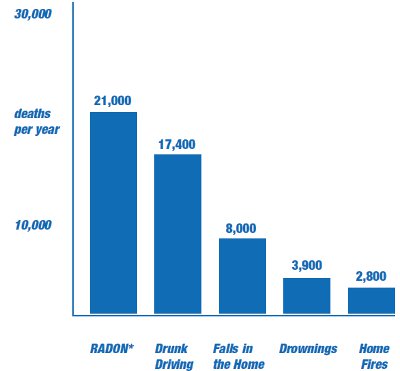
|
|

*According to EPA’s 2003 Assessment of Risks from Radon in Homes (EPA 402-R-03-003).
|
Radon is a radiocative gas
You can’t see radon. And you can’t smell it or taste it. But it may be a problem in your home.
Radon is estimated to cause many thousands of deaths each year. That’s because when you breathe air containing radon, you can get lung cancer. In fact, the Surgeon General has warned that radon is the second leading cause of lung cancer in the United States today. Only smoking causes more lung cancer deaths. If you smoke and your home has high radon levels, your risk of lung cancer is especially high.
|
Why is Radon dangerous?
Radon gas is radioactively unstable substance which provides for radioactive decay. During the decay a number of stable elements are produced as well as othe short-lived radioactive elements. Such products are called Radon Decay Products (RDPs).
In their turn RDPs emmit speical type of radiation called alpha-radiation (α-radiation). Alpha-radiation can cause damage in one's DNA causing cancer.
Where Radon can be found?
Radon can be found all over the U.S.
Radon comes from the natural (radioactive) breakdown of uranium in soil, rock and water and gets into the air you breathe. Radon can be found all over the U.S. It can get into any type of building—homes, offices, and schools—and result in a high indoor radon level. But you and your family are most likely to get your greatest exposure at home, where you spend most of your time.
What to do?
You should test for radon. Testing is the only way to know if you and your
family are at risk from radon. EPA and the Surgeon General recommend testing all
homes below the third floor for radon. EPA also recommends testing in schools.
Testing is inexpensive and easy—it should only take a few minutes of your time.
Millions of Americans have already tested their homes for radon.
...And next
If testing has shown high levels of radon concentration (more than 4.0 pCi/L) you should mitigate.
Radon reduction systems work and they are not too costly. Some radon reduction systems can reduce radon levels in your home by up to 99%. Even very high levels can be reduced to acceptable levels.
Read more
EPA official site devoted to radon
Citizen's guide to radon (pdf)
|